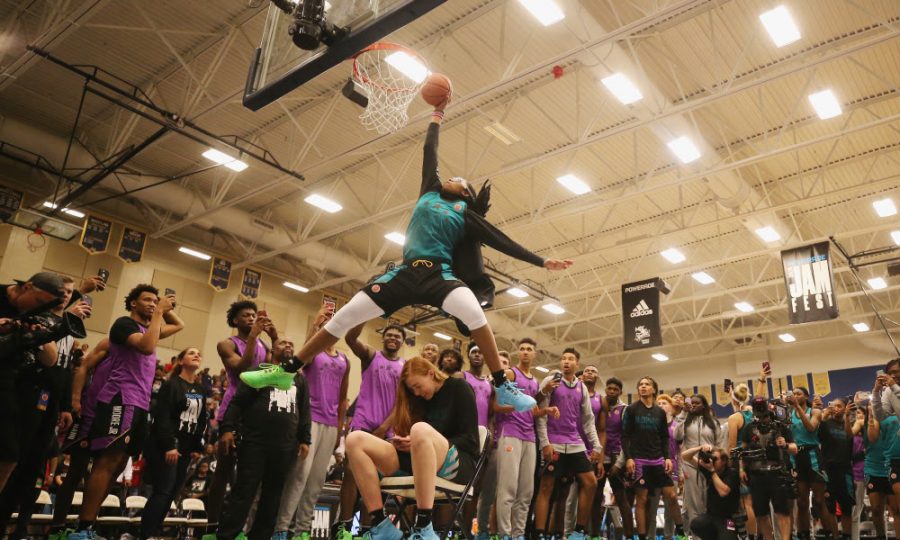These names are just a handful of the greatest hoopers in history. Although you may have heard these names once or twice while skipping through channels during a non-prime time and stumbling across a WNBA game or skimming the sports section of the newspaper, these names are in the shadows of other instantly recognizable names like Steph Curry, Zion Williams, Lebron James, Luka Garza, and James Harden.
Despite the success of women’s basketball players, they are often less valued, less marketed, and treated with less care than men’s players. Apparently, female basketball players can win games, but they can’t win against sexism.
One way this issue manifests itself is in the media’s failure to fuel excitement around female sports. Although 40% of all sports participants are women, women’s sports only receive 4% of all sports media coverage, according to the United Nations Educational, Scientific, and Cultural Organization. In terms of basketball, a lack of marketing creates a widespread impression that women’s basketball is less competitive and entertaining than men’s basketball, which lowers audience attendance and engagement. Men’s college and NBA basketball players and teams are routinely glorified and plastered all over television, billboards, ads, social media, and merchandising. Female basketball players put the same amount of hours into training and honing their skills as men, yet their efforts are typically met with discriminatory comments such as, “Can you make me a sandwich?” or, “Get back in the kitchen.”
In the WNBA, women get paid 22% of shared revenue within their league, while NBA players receive 50%. And no, this is not an issue of talent. Despite some women having physical differences in size and strength compared to men, they can make the same exciting moves. For example, dunking is even becoming more and more common in women’s basketball. Fran Belibi, an incoming junior basketball player at Stanford University, was the first female to dunk in a Colorado High School basketball game in 2017, and she has executed the move in several college games.
Recently, Stanford Women’s Basketball won against Arizona in the national championship game of the 2021 National Collegiate Athletic Association (NCAA) women’s basketball tournament. Yet, their coach, Tara VanDeer, tweeted about the struggles the team faced regarding sexism, despite their national win.
When the Stanford team arrived at the NCAA facilities, they discovered the men’s teams had a better weight room and equipment, more expensive and accurate COVID-19 tests, and even higher quality food. Female sponsorship packages are rarely as lucrative as they are for men. These are only a few examples of how men are more cared for by the NCAA than women.
I play on the varsity girls basketball team at my high school, and even at our level, there is evidence that the athletic department places a lesser value on the girl’s teams.
In past years, the boy’s basketball team was outfitted with new jerseys and an abundance of custom-made gear to wear for games and practices while the girls were still using run-down practice jerseys. The girl’s program has had to do our own fundraising in the form of an annual free-throw-a-thon to purchase items like gear bags and sweats. However, the boy’s teams received gear from funds provided by the athletic department.
When my sister was in the Carlmont basketball program a couple of years ago, the players were upset because the cheerleaders only showed up to cheer at the boys’ games, neglecting the girls’ games. This may seem like a small slight, these non-supportive actions fuel the impression that girls’ teams are less important and less entertaining. Despite the Carlmont girls varsity team having a higher rank in Central Coast Section (CCS) and league standings, the boys varsity team consistently draws far more attendance at quad games.
The final slam dunk needed to tie up the game between men and women basketball is more investment in marketing, sponsorships, and facilities for women’s sports. Women practice, train, and dedicate just as many hours to the game as men do. Some female athletes, like tennis player Serena Williams, have transcended sexist mindsets and are revered as powerful athletes. However, Williams is one of the few women respected in a manner usually reserved for male athletes. Society will only gain a deeper understanding of the commitment of female athletes if the media, sports organizations, and athletic merchandising companies invest in changing sexist perceptions.
There are already initiatives in place to foster this change. Female athletes, such as soccer sensation Alex Morgan, swimmer Simone Manuel, snowboarder Chloe Kim, and WNBA point guard Sue Bird, have already gotten women one step closer to getting the representation they deserve with their new media company called TOGETHERXR. The company’s main goal is to inspire sports companies to further invest in and advertise female athletes. Through initiatives like this, female basketball players and female athletes in general can get the recognition and wages they have worked so hard for.
It’s no secret that sexism devalues women’s basketball at the national, collegiate, and even local levels. Society needs to change its game plan and give female basketball players a winning strategy to defeat inequality once and for all.























Audry Haynes • Sep 24, 2021 at 3:40 pm
If anyone thinks Women’s College Basketball isn’t exciting, they haven’t seen the UConn Huskies pay.